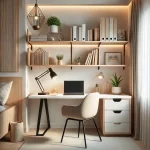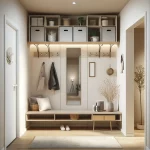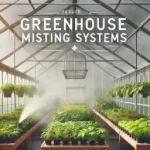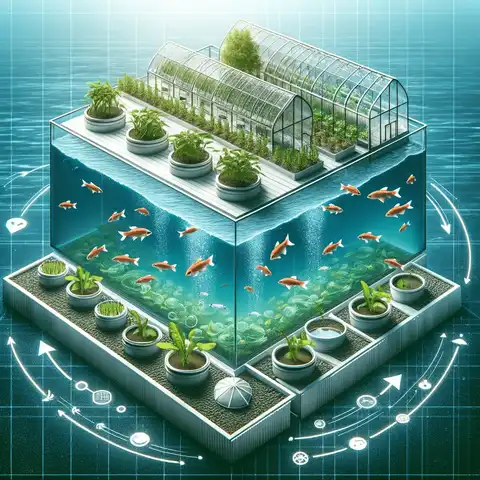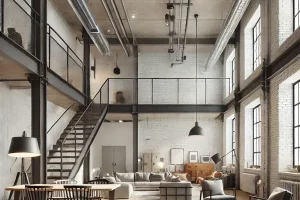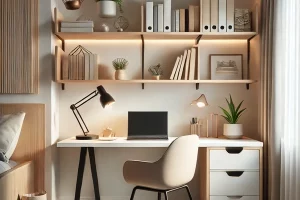What is an Aquaponics Greenhouse? Aquaponics greenhouse is a way to grow plants and fish together. It mixes two neat ideas: aquaculture (which is like raising fish in tanks) and hydroponics (which is growing plants in water instead of soil). This smart mix makes a system where plants and fish help each other out.
- Fish and Plants Team-Up: In aquaponics, fish live in water and make waste, like how we make waste. But here, the fish waste is really useful. It’s full of good stuff that plants need to grow. The plants growing in water, use this waste to get big and strong.
- A Circle of Helping: This is where it gets super cool. As the plants use the fish waste, they clean the water. This clean water goes back to the fish. It’s like a loop – the fish help the plants, and the plants help the fish!
- Good for the Planet: Aquaponics is great for our Earth. It only needs a little water, like regular farming.
- Saving Water and Money: Aquaponics is not just good for nature; it also saves water and money. Since the same water is used over and over and you don’t need plant food from a store, it’s a smart way to grow food.
Key Considerations for Constructing an Aquaponics Greenhouse
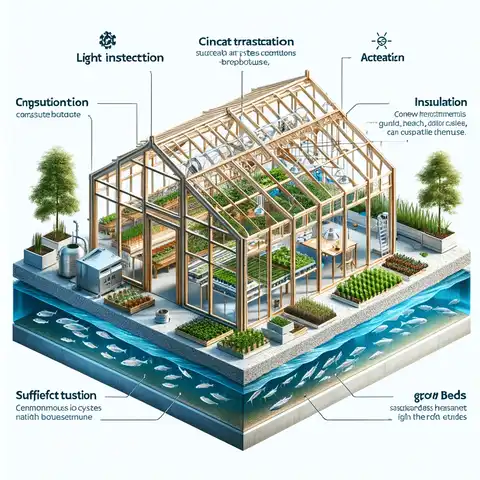
Building an aquaponics greenhouse is great, but there are some important things to make sure it works well and lasts a long time.
Strong and Lasting Structure:
- Why It Matters: The greenhouse needs to be really strong. It should stand up to things like big winds, heavy rain, or even snow.
- What to Do: Use tough materials like strong metal or special plastics that don’t rust or break down easily. Make sure the whole structure, from the roof to the walls, is sturdy.
Keeping the Right Temperature Inside:
- Why It Matters: Plants and fish in your aquaponics system need a comfortable temperature to grow well.
- What to Do: Insulate the greenhouse well. This means covering it with materials that keep the heat in when it’s cold outside and out when it’s hot. You might also need fans or vents to control the temperature and keep the air fresh.
Enough Room for Everything:
- Why It Matters: Your fish tanks, plant beds, and all the pipes and pumps need space. You don’t want it to be too crowded.
- What to Do: Plan your greenhouse size based on how many fish tanks and grow beds you want. Make sure there’s enough room to walk around and work on the system.
Getting Enough Light for the Plants:
- Why It Matters: Plants need sunlight to grow. The light should spread evenly so all plants get their share.
- What to Do: Choose clear materials for the walls and roof that let sunlight through. Sometimes, you might also need artificial lights, especially if it’s not very sunny where you live.
Easy to Get In and Work:
- Why It Matters: You’ll need to take care of the fish, plants, and the system, like feeding the fish and picking the plants.
- What to Do: Design your greenhouse so you can easily reach everything. Have doors and paths wide enough to move around, and think about how you’ll reach the fish tanks and plant beds.
By keeping these key points in mind, you can build a super aquaponics greenhouse. It will be a strong, comfy home for your plants and fish, where they can grow happily, and you can take care of them easily.
Benefits of Aquaponics Greenhouses
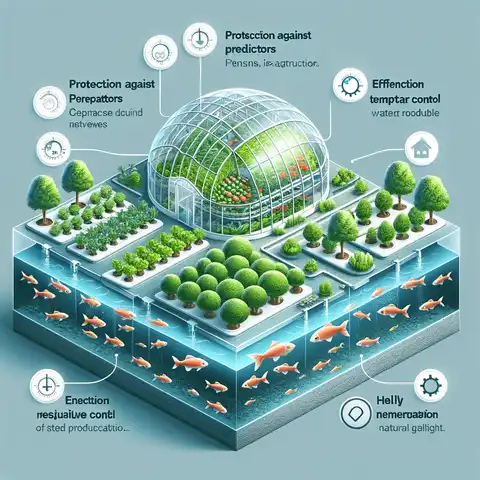
Aquaponics greenhouses are really awesome for a bunch of reasons. Here are the benefits:
- Keeping Safe from Hungry Animals and Thieves: The greenhouse protects our fish and plants from animals that might want to eat them, like raccoons. It also keeps people from taking them. It’s like having a strong, clear fort around our aquaponics setup.
- Just the Right Temperature: Whether it’s hot or cold outside, inside the greenhouse, it’s just right for the fish and plants. It’s like having a cozy, sunny room where they can grow happily.
- No More Worrying About Water: They also help make sure the water stays clean and doesn’t get dirty. This means our fish and plants always have the water they need, and it’s nice and clean.
- Sunshine is the Best: Plants love sunlight, and in a greenhouse, they get plenty of it! The clear walls let in lots of natural light, which is perfect for the plants. And the fish get just the right amount of light without getting too hot. It’s like having a sunny day every day for our plants and fish.
So, these aquaponics greenhouses are like having a special home for our fish and plants where they’re safe, comfortable, and get all the sunlight they need.
Types of Greenhouses Suitable for Aquaponics
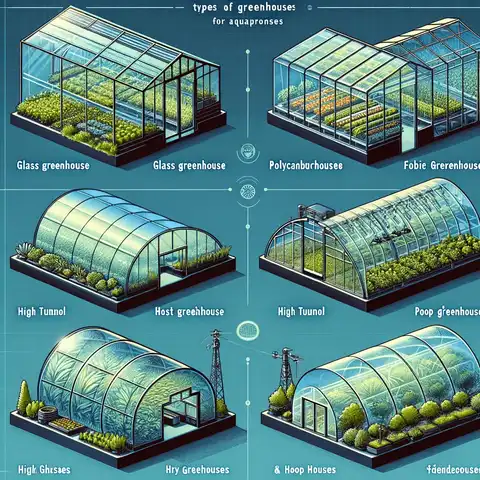
When setting up an aquaponics system, choosing the right type of greenhouse is super important. Here are some great options, each with its perks:
Glass Greenhouses:
- Awesome for Light and Warmth: Glass greenhouses are amazing at letting sunlight in. This light helps plants grow and keeps the place warm.
- A Bit Pricey: The downside is they can be more expensive than other types.
- Why They’re Cool: They look beautiful and last a long time, making them a fancy choice for your aquaponics garden.
Polycarbonate Greenhouses:
- Tough and Cozy: These greenhouses are made of strong plastic that’s really good at keeping the inside warm.
- Kind to Your Wallet: They are less expensive than glass, which is great if you’re watching your budget.
- Why They’re Cool: They do a great job like glass greenhouses but are easier on your pocket and are really durable.
High Tunnel or Hoop Houses:
- Budget-Friendly and Simple to Set Up: These greenhouses are usually covered with special plastic and are pretty cheap.
- Not as Sturdy: They might not last as long as glass or polycarbonate greenhouses, especially in harsh weather.
- Why They’re Cool: If you’re starting or have a small budget, these are a great choice.
Hybrid Greenhouses:
- Best of Both Worlds: Hybrid greenhouses mix features of both glass and hoop houses. They have a strong frame like glass greenhouses but use more affordable materials.
- Durable and Cost-Effective: These are a smart choice if you want a greenhouse that lasts long and isn’t too expensive.
- Why They’re Cool: They give you a bit of everything – durability, good light, and warmth, all while being kinder to your wallet.
Each type of greenhouse has its special benefits, so you can pick the one that fits your needs, budget, and style best for your aquaponics adventure!
Choosing the Right Greenhouse for Your Aquaponics System
When you’re setting up an aquaponics system, picking the perfect greenhouse is a crucial step. It’s not just about the type of greenhouse; it’s about what works best for you, your space, and your budget. Here’s how to make the right choice:
Think About What You Want and Need:
- Your Preferences: What are you looking for in a greenhouse? You may want one that looks a certain way or has specific features.
- Your Budget: How much are you willing to spend? Remember, the cost isn’t just buying it; it’s also about setting it up and keeping it going.
- Climate Conditions: Where you live makes a big difference. If it’s usually cold, you’ll need good insulation. If it’s sunny and hot, you’ll need a way to keep things cool.
- Space Available: How much room do you have? You’ll need enough space not just for the greenhouse but also for walking around it and working inside.
Do Your Homework:
- Research: There’s a ton of info out there. Look up different types of greenhouses and see what others say about them. Find out what’s worked well for people in similar situations as yours.
- Pros and Cons: Make a list of the good and bad points for each type of greenhouse.
Ask the Experts:
- Consult Professionals: Talk to people who know their stuff. This could be someone who’s already running an aquaponics system or professionals who sell greenhouses.
- Visit Aquaponics Farms: Visit places that use greenhouses for aquaponics.
- Join Communities: Online forums, social media groups, or local clubs can be great resources.
Consider Long-Term Aspects:
- Maintenance: Think about how much work each type of greenhouse will need to keep it in good shape.
- Expandability: Might you want to make your setup bigger later on? Some greenhouses are easier to expand than others.
Setting Up Your Aquaponics System
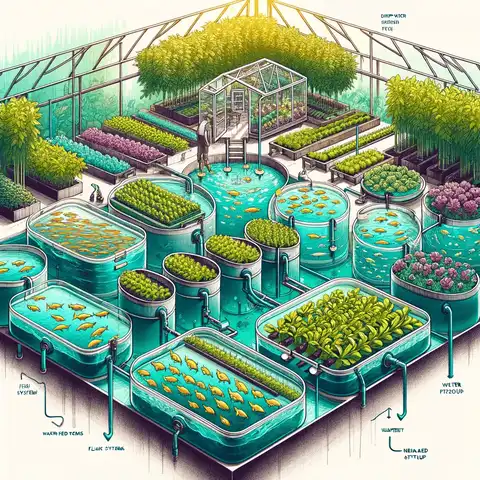
Getting your aquaponics system ready is like setting up a home where fish and plants can live together. Let’s dive into how you can do it:
Setting Up Fish Tanks:
- Clean and Safe Water: Fish need clean water to be healthy. Check the water to make sure it’s not too acidic or basic (that’s the pH) and that it’s the right temperature. Also, test for stuff like ammonia and nitrites that can be harmful.
- Enough Room for Fish to Swim: Fish like to move around, so make sure they have enough space. There’s a rule about how much water you need for each fish – be sure to follow it.
- Keeping the Tanks Clean: Clean the tanks often to take out things like leftover food and fish waste. This helps keep your fish healthy and the water nice for them.
Plant Setup Options:
- Deep Water Setup: In this way, plants float on the water. Their roots hang down in the water, where they get food from the fish waste.
- Water-Fed System: Plants grow with their roots right in the water. The water goes around and around the system, carrying food to the plants.
- Media Bed Setup: Plants grow in a special bed filled with things like gravel. Water from the fish tanks flows through this bed, giving the plants what they need to grow.
Lighting for Plant Growth:
- Natural Sunlight is Best: If you can, put your system where it gets lots of sunlight.
- Artificial Lights When Needed: If there’s not enough sunlight, you can use special lights like LED or fluorescent lights made for growing plants.
- Spread the Light Evenly: Make sure all your plants get enough light. You might need to move your lights around or place your plants in a certain way.
It’s all about making sure your fish have a clean, roomy tank and your plants have the right setup and light to grow. Once everything is in place, you’ll have a happy little world of fish and plants!
System Maintenance and Management in Aquaponics
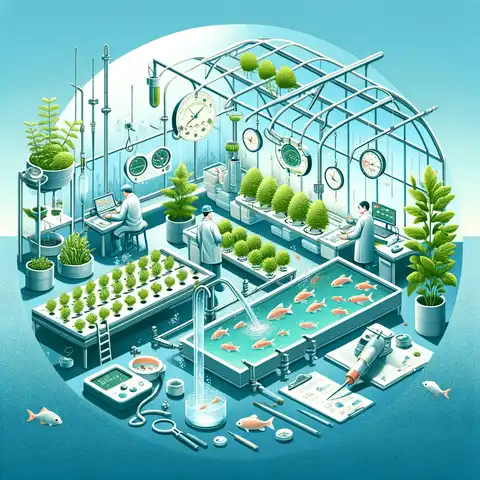
Here’s a guide to help you keep your system thriving:
Regular Monitoring:
- Checking the System: Every day, take a peek at your fish, plants, and the whole system. Make sure everything looks good and works right.
- Water Parameters: Use simple test kits to check the water. You want to make sure it’s just right for your fish and plants.
- Equipment Checks: Make sure all the things that help your system run, like pumps and filters, are working well.
Nutrient and Water Quality Balance:
- Fish Health: The health of your fish directly affects the nutrient supply for the plants. Feed your fish high-quality food and keep an eye on their health to prevent diseases.
- Plant Nutrients: The fish waste feeds the plants. Watch your plants grow and change how many fish you have or how much you feed them if you need to.
- Water Quality Management: Sometimes, take out a little water and put fresh water in. But remember, no chlorine because it’s bad for the fish.
System Adjustments:
- Balancing Fish and Plant Ratio: Make sure there aren’t too many fish or too many plants. Find a good balance.
- Seasonal Adjustments: If your system is outside, you might need to change things when it gets hotter or colder.
Routine Cleaning:
- Cleaning Components: Regularly clean filters, pumps, and grow beds. Remove any debris or waste that could clog the system or degrade water quality.
- Root and Tank Maintenance: Cut plant roots if they get too big and clean the fish tank to keep everything nice and tidy.
Record Keeping:
- Documenting Changes: When you change something or notice something new, write it down.
Choosing Plants and Fish for Your Aquaponics System
Choosing the correct plants and fish is like finding the perfect roommates. Here’s how to choose:
Choosing the Right Plants:
- Think About What Grows Well: Some plants love living in an aquaponics system. Lettuce, tomatoes, and cucumbers are great choices. They grow well and taste delicious!
- What You Like to Eat: It’s also cool to grow what you like to eat. Imagine picking fresh lettuce or tomatoes right from your system for a salad.
- Plant Needs: Remember, some plants need more nutrients than others. So, think about what your fish can provide and match it with the right plants.
Picking the Right Fish:
- Friendly Fish: You want fish that are happy living in the kind of water your plants need. Fish like tilapia, goldfish, or even catfish can be great choices.
- Size Matters: Think about how big your fish will get. You need a tank that’s big enough for them when they’re fully grown.
- Eat or Look: Some people like to grow fish they can eat, like tilapia. Others prefer fish to look at, like goldfish. You decide what’s best for you!
Making Sure They Work Together:
- Balance is Key: The fish make waste that feeds the plants, and the plants clean the water for the fish.
- Not Too Many, Not Too Few: Too many fish or plants can upset the balance. You want just the right amount so everyone is happy and healthy.
Start Simple:
- Easy Does It: If you’re new to aquaponics, start with plants and fish that are easy to care for.
Choosing the right plants and fish for your aquaponics system is really fun. Start with the basics, learn as you go, and soon you’ll have a thriving aquaponics garden!
Final Touches and Considerations for Your Aquaponics System
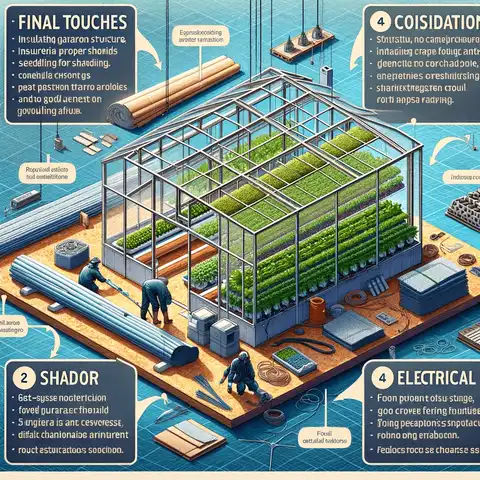
After setting up your aquaponics system, there are a few final touches and considerations to ensure everything runs smoothly and efficiently. These steps are crucial for the long-term success of your system:
Insulate and Shade the Greenhouse:
- Keep the Temperature Just Right: Insulating your greenhouse helps keep the inside temperature stable – not too hot, not too cold.
- Shade for Comfort: In really sunny places, shading can help keep your plants and fish from getting too hot. Think about using shade cloths or positioning your greenhouse where it gets some natural shade.
Choose Fish That Like Your Weather:
- Climate-Friendly Fish: Pick fish that are happy in the climate you live in. If it’s warm where you are, tilapia might be a good choice. In cooler places, trout might work better.
- Keeping Fish Comfy: Make sure the water in your system is just right for the fish you choose. This means checking the temperature and making sure it stays consistent.
A Good Floor for Water Drainage:
- Avoid Waterlogging: A floor with good drainage is important. You don’t want water pooling up in places.
- Flooring Options: Gravel floors are great for drainage. Or, if you prefer, you can use a solid floor with a good drainage system built in.
Get Help with the Electrical Stuff:
- Safety First: Setting up the electrical parts of your system, like pumps and lights, can be tricky.
- Call in the Experts: Don’t be shy about getting help from someone who knows about electrical systems.
Final Checks and Balancing:
- Walk-Through: Before you start using your system full-time, do a final check of everything. Make sure all parts are working together nicely.
- Balance Check: Give your system a little time to balance out. This means letting the fish and plants settle in and making sure the water is circulating properly.
Putting these final touches on your aquaponics system is like dotting the i’s and crossing the t’s.
FAQs About Aquaponics Greenhouses
What is an Aquaponics Greenhouse?
It’s a special place where you can grow plants and keep fish at the same time! Imagine a big house where fish swim in water and plants grow in that same water. The fish and plants help each other grow.
Why Use a Greenhouse for Growing Plants and Fish?
A greenhouse is like a magic house where you can make it warm or cool and bright for the fish and plants. It keeps them safe from too much rain, wind, or bugs.
What Plants Grow Well in an Aquaponics Greenhouse?
Plants that love water, like lettuce, spinach, and herbs, are perfect. You can also grow yummy vegetables like tomatoes and cucumbers.
What Fish Are Good for an Aquaponics Greenhouse?
Fish like tilapia, trout, and goldfish are great. The best fish for your greenhouse depends on where you live and what plants you want to grow.
Do You Need Special Things for an Aquaponics Greenhouse?
Yes, you need a home for the fish (tanks), a way to move the water around, places for the plants to grow, and maybe things to keep them warm and give them light.
Can You Build an Aquaponics Greenhouse Anywhere?
You can build it in most places! Just make sure there’s enough light, and you can keep the inside warm or cool as needed.
How Much Does it Cost to Make an Aquaponics Greenhouse?
It can cost a little or a lot, depending on how big it is and what you use to make it. It could be a few hundred dollars or even more.
Is it Hard to Take Care of an Aquaponics Greenhouse?
At first, it takes some work to learn about caring for the fish and plants and checking the water. But it gets easier and is really fun!
Can You Grow Food All Year in an Aquaponics Greenhouse?
Yes, you can! The greenhouse lets you grow food all the time, even when it’s cold outside.
Are Aquaponics Greenhouses Good for the Earth?
They are really good for the Earth! They use less water than normal farming, don’t need chemicals, and you can use sun power to run them.


